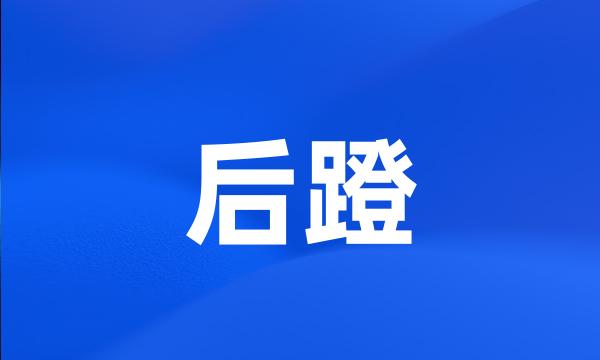后蹬
- 网络leg-drive backward
 后蹬
后蹬-
髋受力后蹬式Wingate无氧功率测试法的生物学特征分析
The Biological Characteristic Analyses on Wingate Anaerobic Test with Hip Stress Leg-driving
-
从生物化学的角度分析跳远跑训练的主要练习方法&间歇快速30m~60m后蹬跑、60m冲刺跑,并结合训练实践,指出在训练中应解决的主要问题。
A major exercise method intermittent quick 30 ~ 60m backward stride and 60m sprint run was analyzed from the view of sports biochemistry . The main problems which need solving were also pointed out .
-
试论后蹬跑对现代短跑后蹬技术的影响
Influence of Back Step Running to Back Step Technology of Modern Sprint
-
后蹬阶段的摆动是体前摆动。
The swing du the pressing period is the swing in front of the body .
-
关于短跑后蹬角度若干问题的探讨
Probe into a Few Questions on the Angle of the Rear Leg During the Dash
-
对短跑途中跑屈蹬式和后蹬式技术的比较研究
Comparative Research on the Skill of Bent-leg Drive Mode and Bent Drive Mode of Sprint 's Midway Running
-
对短跑途中跑支撑脚后蹬扒地技术的初步探讨
Discussion on the Technique of Pressing Down the Supporting Foot Backward to Hold on to Ground in Dash
-
后蹬力是短跑主要的动力来源,是推动人体前进的基本条件。
The strength of the rear leg which is essential to push the body forward is the main sours of movement .
-
从理论和实践上分析了传统短跑后蹬跑练习与现代屈蹬式短跑技术的不同特点。
This paper analyzes the difference between back step training of traditional sprint and bent step technology of modern sprint from theoretical and practice .
-
下肢爆发力不足和踝关节力量薄弱是造成后蹬角大着地角小的原因。
Anaerobic Power shortage and the weakness of the ankle is caused by a large angle of the ground after kicking the reasons for the small angle . 5 .
-
操作简便:助力滑行,后蹬踏动力杆,即可加速滑行,如驾云般飘逸,有骑马般自在。
User-friendly control : glide with the help the dynamic device , speeding by pedaling the pole , then you will be as graceful as clouds and comfortable as riding horses .
-
采用多功能力量训练器和远固定髋受力下肢力量训练器分别测定94名从未用过髋受力训练器的受试者的最大下肢力量和最大后蹬力量。
Multifunction strength training apparatus and far fixed hip stress lower limb strength training apparatus were respectively used to test the maximal lower limb strength and maximal driving strength of 94 objects .
-
运用运动生物力学的基本原理,结合田径运动理论知识,对短跑的动作周期划分为后蹬、着地缓冲等问题进行了剖析。
Based on the biomechanics basics and the knowledge of the track and field , the essay argued on the sprint skill periods and the term of leg drive , the buffer after landing , and so on .
-
背景:人类后蹬力量可能是一种未能有效开发并具有极大开发潜力的动力源,阐明后蹬力量与下肢力量的关系对人体运动科学理论的发展具有重要意义。
BACKGROUND : The driving strength may be an undiscovered power source with a great developing potential . To clarify the relationship between driving strength and lower limb strength is of great importance to the development of the theory of human movement science .
-
初中组与小学组投手的下肢技术问题较多,主要有后蹬角偏大,大腿高抬不足,送髋不充分,伸踏腿前蹬角偏大等,影响出手速度。
Junior Secondary and primary school pitcher of the lower limbs more technical issues , mainly after the tread angle too large , the lack of elevation thigh , hip does not send the full , extended leg before riding tread angle too large , hand speed impact .
-
停训后SJ形式蹬伸力量的动力学分析
Dynamic analysis of speed force with SJ in detraining
-
实验后加速阶段蹬伸离地时刻运动学指标显示躯干前倾角和一个复步距离有显著性差异,经身体核心力量训练后途中跑阶段蹬伸离地时刻躯干前倾角有显著性差异。
After experiment , the accelerated phase of kicking off the ground time kinematic indicators suggest that the trunk before the dip and a recovery step are significant different ; and after the body core strength training Running stage kicking off theground moments trunk anteversion are significant different as well .
